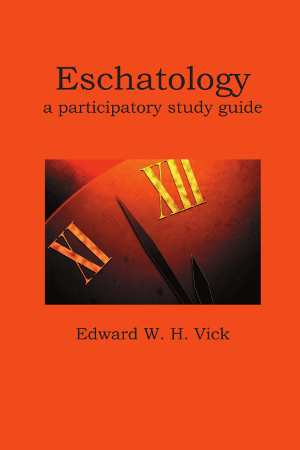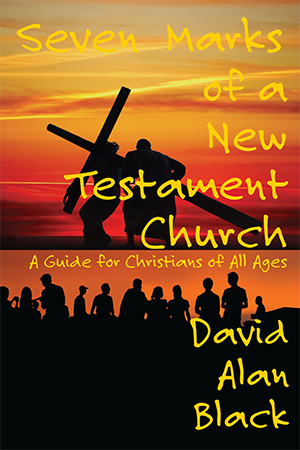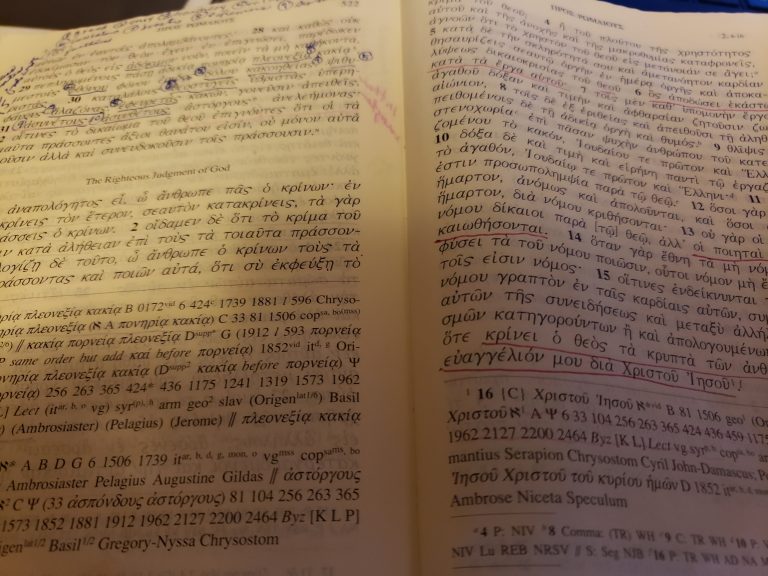The Problem with Eschatology
I grew up in the Seventh-day Adventist Church, which is very interested in eschatology. We didn’t learn the term all that early, but we were subjected constantly to sermons about it. SDA eschatology is one of the key reasons I’m not SDA any more, but when I first joined a United Methodist congregation, I was surprised to discover that nobody really thought that much about the end times. One pastor I know had even invited an SDA to come in and teach on Revelation. Why? “SDAs know something about eschatology.” Of course, the corollary to that was that Methodists did not.
But SDAs were not the primary source for the congregation. Most of them picked up what eschatology they knew from television and other popular media, which meant some kind of futurist interpretation including a seven-year tribulation, usually a pre-tribulation rapture, and a pre-millenial second coming. This eschatology, while built on a dispensational view of biblical interpretation and theology, was held without necessarily accepting, or even knowing, its theological foundations.
Most Methodist pastors that I encountered during this time didn’t really teach or preach about eschatology. They preferred to avoid it. They might say that Methodists weren’t really committed to a particular eschatology. Some accepted the “left behind” eschatology themselves. But in general there was, and is, a void in this area of theology.
Let me warn readers at this point that this is one of my posts reflecting on a book I have published. There won’t be much of a commercial, however. I’m just giving some of my thoughts on eschatology and why we should pay attention to it in the church.
I believe the reason many pastors and teachers don’t talk about eschatology is that it has a bad reputation amongst those theologically trained. There is so much craziness that goes on, such as setting dates for the end of the world, that people just don’t want to go there. The “left behind” theology and the futurist view of the interpretation of Daniel, Revelation, and other apocalyptic literature is popular because it is proclaimed almost in a vacuum. If people hear only one view proclaimed, they can perhaps be forgiven for thinking it is the way to think about eschatology.
And I believe that groups with even more peculiar views of the last days find an opening amongst Christians simply because pastors and teachers haven’t addressed the issues at all. I recall a comment by my uncle on a sermon which he called “fearfully and wonderfully made.” He didn’t intend it positively. Most systems or programs about the end time are, in that sense, “fearfully and wonderfully made.” They are also houses of cards, to be blown over if anyone studies the texts themselves without the guide. I find the SDA interpretation of the seals and trumpets of Revelation to be ridiculous, and rejected them while I was still a college student in an SDA school. But if you hear just that view, and look at just the texts (and the emphasized portions of texts) than an evangelist or other presenter wants you to see, it can sound very plausible.
But even more importantly, eschatology is critical. It’s where we’re going. It’s why we are the church. I don’t mean to diminish the importance of now, and there are views of eschatology that do not diminish that importance. That’s something to consider. But when you’re making a decision as to what to do and how to do it, knowing where you’re going is important. One result of bad eschatology is the idea that because Jesus is coming soon (and just what does “soon” mean?) we don’t need to take care of the planet we’re living on. Why bother, when it’s all corrupted by evil and about to be destroyed in the fires of hell?
The answer is to take this subject on directly, and as frequently as necessary to counter popular Christian culture. It is also important not to just teach some alternate scheme of the end times. Too often we teach conclusions in the church (and even in seminary), and not how to come to those conclusions, and yes, how to challenge them.
 That is what Dr. Edward W. H. Vick does in his study guide, Eschatology: A Participatory Study Guide. Interestingly enough, Dr. Vick is a Seventh-day Adventist. But he isn’t teaching the SDA evangelistic message. He’s surveying the field of eschatology and teaching readers and students the terminology and the ideas they need in order to understand the discussion of this field. It isn’t a simple book, but it is direct and straightforward. You’ll need to study it carefully, lesson by lesson. You can’t jump in somewhere in the middle. It won’t tell you what you should believe about eschatology. It will provide you with the tools to study the topic and to understand what others are saying.
That is what Dr. Edward W. H. Vick does in his study guide, Eschatology: A Participatory Study Guide. Interestingly enough, Dr. Vick is a Seventh-day Adventist. But he isn’t teaching the SDA evangelistic message. He’s surveying the field of eschatology and teaching readers and students the terminology and the ideas they need in order to understand the discussion of this field. It isn’t a simple book, but it is direct and straightforward. You’ll need to study it carefully, lesson by lesson. You can’t jump in somewhere in the middle. It won’t tell you what you should believe about eschatology. It will provide you with the tools to study the topic and to understand what others are saying.
I accepted this manuscript for publication because I think we need to think, study, and teach more on this topic. I am also convinced that on every topic we need to let people know not just what we conclude, but how we came to those conclusions. It builds on what Dr. Vick has already said in his books From Inspiration to Understanding: Reading the Bible Seriously and Faithfully, and The Adventists’ Dilemma. The latter volume will be of particular interest to SDAs who often wonder just what “soon” means when you’ve been proclaiming that Jesus is coming soon for a couple of hundred years. Don’t worry. The church has been doing it for 2000 years. But perhaps we don’t know what “soon” means.
There are those who may be concerned about using a book on this subject written by someone from a group that has peculiar views on eschatology. Let me assure you that Dr. Vick treats eschatology as an academic subject. I’m not going to try to characterize his view of SDA eschatology. I’ll simply say that in this book he presents an overview of this topic that is broad, intense, and extremely helpful.
(If you’re interested in pursuing a study of basic eschatology in that manner, this will be the book for you. If you’re considering this book for use in your church, remember that you can request a free evaluation copy simply by e-mailing Energion Publications with a note telling us your intended use and the size of the group you intend to use it with.)




check out http://www.aletheia.ws/eschaton-revisited
/ Yo Henry. Nice blog. Seen the following? It was observed by me on the www. Enjoy. /
PRETRIB RAPTURE STEALTH !
Many evangelicals believe that Christ will “rapture” them to heaven years before the second coming and (most importantly) well BEFORE Antichrist and his “tribulation.” But Acts 2:34, 35 reveal that Jesus is at the Father’s right hand in heaven until He leaves to destroy His earthly foes at the second coming. And Acts 3:21 says that Jesus “must” stay in heaven with the Father “until the times of restitution of all things” which includes, says Scofield, “the restoration of the theocracy under David’s Son” which obviously can’t begin before or during Antichrist’s reign. (“The Rapture Question,” by the long time No. 1 pretrib authority John Walvoord, didn’t dare to even list, in its scripture index, the above verses! They were also too hot for John Darby – the so-called “father of dispensationalism” – to list in the scripture index in his “Letters”!)
Paul explains the “times and the seasons” (I Thess. 5:1) of the catching up (I Thess. 4:17) as the “day of the Lord” (5:2) which FOLLOWS the posttrib sun/moon darkening (Matt. 24:29; Acts 2:20) WHEN “sudden destruction” (5:3) of the wicked occurs! The “rest” for “all them that believe” is also tied to such destruction in II Thess. 1:6-10! (If the wicked are destroyed before or during the trib, who’d be left alive to serve the Antichrist?) Paul also ties the change-into-immortality “rapture” (I Cor. 15:52) to the end of trib “death” (15:54). (Will death be ended before or during the trib? Of course not! And vs. 54 is also tied to Isa. 25:8 which Scofield views as Israel’s posttrib resurrection!) It’s amazing that the Olivet Discourse contains the “great commission” for the church but not even a hint of a pretrib rapture for the church!
Many don’t know that before 1830 all Christians had always viewed I Thess. 4’s “catching up” as an integral part of the final second coming to earth. In 1830 this “rapture” was stretched forward and turned into an idolized separate coming of Christ. To further strengthen their novel view, which evangelical scholars overwhelmingly rejected throughout the 1800s, pretrib teachers in the early 1900s began to stretch forward the “day of the Lord” (what Darby and Scofield never dared to do) and hook it up with their already-stretched-forward “rapture.” Many leading evangelical scholars still weren’t convinced of pretrib, so pretrib teachers then began teaching that the “falling away” of II Thess. 2:3 is really a pretrib rapture (the same as saying that the “rapture” in 2:3 must happen before the “rapture” [“gathering”] in 2:1 can happen – the height of desperation!). Google “Walvoord Melts Ice” for more on this.
Other Google articles on the 183-year-old pretrib rapture view include “X-Raying Margaret,” “Margaret Macdonald’s Rapture Chart,” “Pretrib Rapture’s Missing Lines,” “Edward Irving is Unnerving,” “The Unoriginal John Darby,” “Catholics Did NOT Invent the Rapture,” “The Real Manuel Lacunza,” “Thomas Ice (Bloopers),” “Wily Jeffrey,” “The Rapture Index (Mad Theology),” “America’s Pretrib Rapture Traffickers,” “Roots of (Warlike) Christian Zionism,” “Scholars Weigh My Research,” “Pretrib Hypocrisy,” “Appendix F: Thou Shalt Not Steal,” “Pretrib Rapture Secrecy,” “Deceiving and Being Deceived,” “Pretrib Rapture Dishonesty,” “Famous Rapture Watchers,” and “Morgan Edwards’ Rapture View” – most by the author of the bestselling book “The Rapture Plot” (the most accurate and documented book on pretrib rapture history which is obtainable by calling 800.643.4645).
The Apostle John wrote in Revelation 1:1, of those thing which must shortly come to pass, meaning the end time events which when they start to occur will rapidly fall in place much lined dominoes topple one upon one another once the first falls; the eschatology details are as follows.
As is seen in Revelation 6:1-2, Jesus Christ, on October 23, 2013, partially opened, on then again on May 12, 2014, fully opened, the First Seal of the Scroll of End Time Events, thereby releasing the Rider on the White Horse, who has the Bow of Economic Sovereignty, that is the Bow Without Any Arrows, to effect coup d etats world wide, to transfer sovereignty from democratic nation states to fascist regional leaders and bodies, thus destroying the monetary authority of the world central banks, and establishing the economic authority of regional governance in the world’s ten regions, and totalitarian collectivism in mankind’s seven institutions, as is seen in Revelation 13:1-4.
The death of currencies, and also the failure of credit, that is failure of trust in the monetary policies of the world central banks to continue to provide investment gains and global economic growth on May 13, 2014, comes from the Rider on the White Horse seen in Revelation 6:2, being given a crown, that is the authority to rule over the nations, with the Bow of Economic Sovereignty, calling Interest Rates higher from 2.49%, and is exemplified in the trade lower in Ireland, EIRL, Italy, EWI, Greece, GREK, and the European Financials, EUFN, coming from the strong trade lower in the Euro, FXE, and has commenced destructionism, replacing the former inflationism, as the dynamic of economic activity.
Through the First Horseman’s endeavors, a One Euro Government, that is a fiscal, banking, and totally fascist economic union, will emerge in the Eurozone; it will be the model for policies of regional governance, and schemes of totalitarian collectivism in all of the world’s ten regions, this being foretold in Revelation 13:1-4, as well as Daniel 2:20-45.
Largely through the work on the soon to be revealed Sovereign, seen in Revelation 13:5-10, and his economic high priest, the Seignior, seen in Revelation 13:11-18, the EU’s power will become so great, that it will be the preeminent world power.